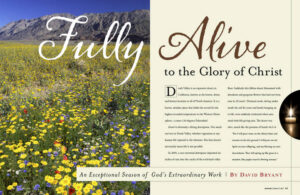2nd Page
By David Bryant
 Death Valley is an expansive desert in California, known as the lowest, driest, and hottest location in all of North America. It is a barren, desolate place that holds the record for the highest recorded temperature in the Western Hemisphere—a mere 134 degrees Fahrenheit!
Death Valley is an expansive desert in California, known as the lowest, driest, and hottest location in all of North America. It is a barren, desolate place that holds the record for the highest recorded temperature in the Western Hemisphere—a mere 134 degrees Fahrenheit!
Death is obviously a fitting description. Not much survives in Death Valley, whether vegetation or any human life exposed to the elements. But that doesn’t necessarily mean life is not possible.
In 2005, a rare torrential downpour deposited six inches of rain into the cracks of the rock-hard valley floor. Suddenly this lifeless desert blossomed with abundant and gorgeous flowers that had not been seen in 20 years! Dormant seeds, sitting underneath the soil for years and barely hanging on to life, were suddenly awakened when saturated with life-giving rain. The desert was alive, much like the promise of Isaiah 44:3-4:
“For I will pour water on the thirsty land, and streams on the dry ground; I will pour out my Spirit on your offspring, and my blessing on your descendants. They will spring up like grass in a meadow, like poplar trees by flowing streams.”
This is a picture of revival—when the Spirit saturates a church with God’s Word about God’s Son so that God’s people come alive to His glory in whole new ways.
Revival: A Look Back and Forward
Revival, interestingly enough, was a shared experience by saints in both Old and New Testaments. There was a difference, however, between the two eras in how the experience played itself out.
In the Old Testament, the reviving of Israel was usually characterized by a look back, as the nation sought to return to previous high‑water marks in Israel’s religious pilgrimage. Note how Elijah on Mt. Carmel challenged Israel to return to days of spiritual faithfulness before Baal worship had taken over (1 Kings 18). Or recall how Hezekiah refurbished the time-worn temple and reinstituted the ancient Passover tradition, shaping the revival that emerged under his watch.
In the New Testament, however, revival is characterized much more as a look forward. It is focused on fresh extensions of Christ’s reign among His people and into the world. Consider the prayer meeting of Acts 4: what they prayed, how God answered, and the aftermath in the succeeding stories of missionary advance—all forward-looking. In a Christ‑dominated revival, the Holy Spirit increases vision for what’s ahead. He deepens our yearnings for greater approximations of the coming Kingdom.
In New Testament-style revival, Christians are aroused to a reality of Christ’s presence and power already theirs, but currently overlooked. They are summoned not only to recapture their first love for Christ (Rev. 2), but also to discover a passion for Him that surpasses whatever they have known before (Eph. 3). Reawakening us to greater dimensions of His glory, New Testament revival is ultimately about recovering and enlarging hope in Christ.
That’s why, as Jonathan Edwards (pastor/scholar of the 1700s) observed, revival is arguably the most dramatic display of Jesus’ Lordship in the present age. In no way depreciating God’s “ordinary” work with us on a daily basis, revival is an exceptional season of His “extraordinary” work among us.
In other words, God infuses His Church with fresh hope, passion, prayer, and mission by refocusing us on Christ for all He really is. In revival a church is recaptivated with the supremacy of Christ by the Spirit of Christ. That’s why my favorite term for this phenomenon is a “Christ Awakening.”
Revival is more than just an event in a church calendar. When God re‑energizes a community of Christians, He intends Kingdom results that last many years. Scholars’ research verifies that, following each of the four so-called “Great Awakenings” in American history (early 1700s, late 1700s, mid 1800s, early 1900s), decades of documented transformations took place both in churches and in society.
God gave His people “fresh winds,” not simply to fire up enthusiasm for spiritual things, but also to extend further the reign of His Son within communities and nations through His Church.
When Christ Reigns through Revival
Here’s one story to demonstrate how revival can impact a whole nation for Christ’s Kingdom.
At the close of the 20th century a wonderful move of God came to the beleaguered nation of Uganda. Once known as the “jewel of Africa,” this beautiful land had become devastated physically and spiritually by multiple oppressive regimes headed by diabolical dictators. Economically, Africa’s breadbasket had become its worst “basket case.” Most distressing, tens of thousands of Christians were martyred for their faith, many by unspeakable tortures.
As a result, in the late 1990s hundreds of thousands in the churches began to cry out to God for a spiritual awakening in their land. The believers grappled with the need for soul-searching repentance inside the Church. They confessed all the ways they were actually complicit in His judgments on Uganda as a whole. Broken in spirit, they pled for God’s mercy.
Finally, God answered their cries. Joyous confidence about Christ’s Kingdom reignited their churches. Passion for the Promise-Giver once again marked thousands of congregations large and small.
But this was just the beginning of revival. At the same time, ungodly strongmen were unexpectedly expelled. Corrupt structures of oppression were decisively dismantled. Political and religious prisoners were set free. Persecution of the Church came to an end. A devoutly righteous Christian leader became Uganda’s president. He made his first official act a public re-dedication of the entire nation to Jesus Christ as its Lord!
Following that, to the amazement of all, significant economic recovery began. Far more importantly, a nationwide commitment to sexual abstinence turned back the plague of AIDS in this nation once known for the largest epidemic in Africa. It rendered Uganda the country with the least threat of AIDS—all in just one decade! Furthermore, some of the largest churches in Africa can now be found there, with one in Kampala growing from a few hundred to nearly 15,000 in five years. Fasting and prayer are a way of life for Ugandan Christians as they seek even deeper manifestations of Christ’s reign in their generation.
The Arrival of Christ
Steve Hawthorne suggests revival might be renamed arrival. It’s as if Christ “shows up” in His Church afresh to recapture us and reconquer us.
Isaiah 60 suggests God’s glory was already breaking over Israel like a sunrise, exposing many dimensions of His Kingdom purposes to them. What they needed to do was “rise and shine” and seize the day.
That’s why biblical texts frequently use the motif of encounter to describe spiritual renewal. We find this in Isaiah’s picture of a future when God would rend the heavens like a garment, visibly descending like a fire upon saints and nations alike (Isa. 64).
The Puritans coined a great phrase to define the “arrival” experience. They called such seasons “the manifest presence of Christ.” Here is how they reasoned: First, they said, there is Christ’s essential presence. That is, Christ is everywhere present all the time. He is unavoidable.
Second, they also talked about Christ’s cultivated presence. Christians can enrich their sense of fellowship with Him as they abide in Him day by day, faithfully obeying Him. We can cultivate a deeper knowledge of the Lord through Bible study and prayer, for example. As we do, Christ shows Himself to be much more present in our lives than we had realized.
The manifest presence of Christ, however, was something else altogether. This was the Puritans’ third term for those times when God reveals His Son to a new generation of His people. He does so in such dramatic fashion that it almost seems as if Christ has been hiding from us until that moment. Then suddenly He reinserts Himself among us. He arrives, in other words.
Or, as I define it, revival is a “Christawakening movement.” It is God’s people waking up to God’s Son for all He is, not only individually but also corporately; not only in a moment but for a season. Revival ultimately becomes a movement with wide-reaching impact on society as well as among the nations.
Revival Is a Coronation
One could almost say that revival is like a coronation. In other words, it leads believers to reaffirm their wholehearted devotion to the Lamb who sits on the Throne (Rev. 5). It reconnects them to His marching orders as their King. It serves as a powerful sign of the supremacy of Christ. The renewing reality of revival should be basically defined as this: Jesus expressing Himself more fully to His people as Lord.
In fact, one cannot think rightly about revival at all if one does not think rightly about the glory of God’s Son, Jesus Christ. He is the criterion by which we measure both revival’s legitimacy and its impact. The final revival will emerge from fresh in-breakings of Christ’s sovereign dominion before every creature in heaven and earth.
But until that final consummation, our Redeemer intends to continue invading His Church, extending His Lordship among us, regaining the praise He rightfully deserves, and enlarging His mission through us among all earth’s peoples.
Jonathan Edwards was on target. Revival is one of the most exciting expressions of Christ’s supremacy any Christian can experience until He comes again. It is prior and primary. It is the prelude to all other manifestations of Christ’s reign for, in, and through His people.
Many believe a gracious “Christ Awakening” even now is bearing down on top of us, in answer to today’s unprecedented global prayer movement. May it be so!
DAVID BRYANT directs Proclaim Hope, a ministry devoted to fostering and serving a nationwide Christ-awakening movement. He is the former chairman of America’s National Prayer Committee
 This article is taken from “Fresh Fire: Hope for a Christ-Centered Revival,” which is issue 2 of Prayer Connect magazine. To order a hard copy of this issue, click here.
This article is taken from “Fresh Fire: Hope for a Christ-Centered Revival,” which is issue 2 of Prayer Connect magazine. To order a hard copy of this issue, click here.